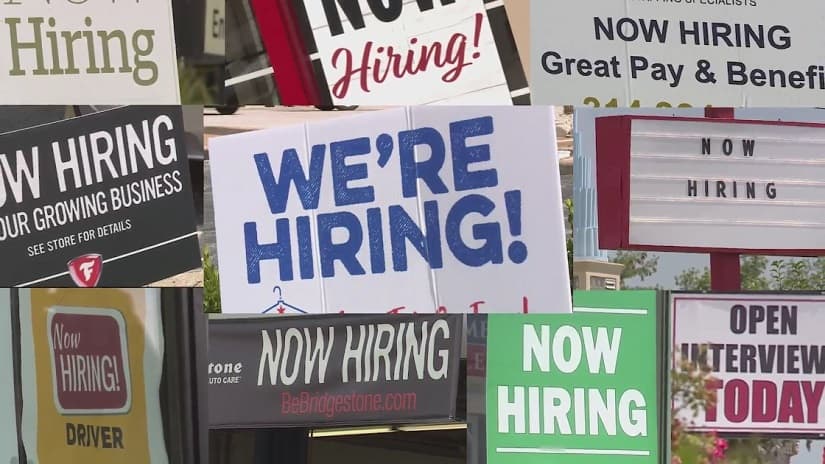

2021 was marked by challenges and change—a year for the books. Its chapters: The Great Resignation; The War for Talent; Resignation Nation; Turnover Tsunami; The Great Attrition; ‘Striktober and The Labor Market Fallout—kept businesses turning the pages—hoping for a better ending. But it didn’t come.
These coined terms—backed with the latest data from the U.S. Bureau of Labor Statistics—adds to the labor outlook story and suggests that The Great Resignation will roll on in 2022.
According to the BLS, more than 4.5 million people voluntarily left their jobs in November. That was up from 4.2 million in October and was the most in the two decades that the government has been keeping track. And with a sharp rise in COVID-19 cases in December and January already weighing on demand in high-contact service sectors, new headwinds for the labor market will create a bigger impact on labor supply.
Results from a study conducted in November 2021 by the US Chamber of Commerce, also suggested that labor shortages could even be permanent, given how many people left jobs during the pandemic and have not returned to work.
Although it’s a new year—there aren’t many indicators that the labor shortage is going away anytime soon. So, what comes next when demand for workers has recovered, but the number of willing workers has not?
The latest Pew Research report shows how the gig economy has ushered in new way of connecting people with consumers and those who want to hire them. A vast majority of U.S. adults—94% according to their report—believe gig platform jobs are a generally good way to earn extra money as a side job or to have the ability to work a flexible schedule.
Certainly, the emergence of companies like Uber, TaskRabbit, DoorDash and Hyer—have expanded the way people earn money and added another dimension to today’s the labor force. A welcoming one for gig workers and businesses alike.
McKinsey & Company’s latest labor report, The Great Attrition of 2021, employees resigning in record numbers—continues unabated. In a recent survey they discovered that 58% of employees indicated that they were somewhat likely to almost certain to quit in the coming months. Likewise, a majority of the employers participating in the research were experiencing record levels of turnover and expected it to continue.
Parents, who have faced some of the harshest conditions during the COVID-19 pandemic, are joining this exodus with gusto—looking for more flexible work opportunities, from taking time off and starting their own businesses to turning to gig roles. And for good reasons. One of them, the lower-income respondents said, is that this type of work affords them more flexibility to care for family. A trend that fueled gig workers to flock to Hyer in 2021–where we saw a 208% increase in Taskers downloading the app. A number reflective of a bigger shift in the way people want to work.
According to Dollar Sprout’s 2021 Side Hustle Report, side gig jobs are becoming more like main gigs for many Americans.
41% percent of gig workers relied on their gig jobs to cover monthly expenses in 2021—up from 27% in 2020.
The percentage of people spending more than 15 hours per week on gig work more than doubled in 2021 as well, increasing from 12% to 27%.
The share of gig workers who earned more than $1,500 per month increased from around 4% in 2020 to more than 14% in 2021.
All of that to say, for a lot of gig economy workers, gig work is no longer just a temporary hobby. The pandemic gave American workers a lot of time to reflect on what’s important. Overwhelmingly freedom and flexibility became their north star. The freedom to set their own hours, be their own boss, have more work/life balance and feeling more fulfilled in what they do has certainly fueled a new phenomenon that’s here to stay. One that can also bring businesses back to life if they’re willing to grab hold of it.
Deloitte’s latest report points to a greater gig strategy this year. Steve Hatfield, Global Future of Work Leader at Deloitte said, “In 2022 temporary and “gig” workers will be an increasingly important part of the workforce, which presents both opportunities and challenges for organizations. In this free-market economy, individuals may work for multiple employers at the same time. Employers are just fine with that, as the arrangement gives them the flexibility to staff and up-down to meet fluctuations in demand.”
Businesses have a lot of incentives to embrace this trend. Chief among them is flexibility. Hatfield noted that, “Companies are finding that many roles that were long assumed to require workers can be permanently redefined or broken up to accommodate contractors. Gig workers can also supplement full-time staff for short-term assignments requiring specialized expertise or seasonal changes in activity. An option that makes the employer’s job even easier—providing a reliable workforce without the overhead costs.”
A win-win where workers get the flexibility they crave and businesses meet their labor demands while boosting their bottom line.
In 2022, something’s got to give. Organizations must go beyond the traditional staffing playbook and take innovative, decisive actions—which Deloitte says includes tapping gig work through company-owned or third-party labor platforms. “There’s no question, though, that flexible labor will become a more entrenched part of the workforce. This will require organizations to think more strategically about how work is done.” We couldn’t have said it better.
| Cookie | Duration | Description |
|---|---|---|
| cookielawinfo-checkbox-analytics | 11 months | This cookie is set by GDPR Cookie Consent plugin. The cookie is used to store the user consent for the cookies in the category "Analytics". |
| cookielawinfo-checkbox-functional | 11 months | The cookie is set by GDPR cookie consent to record the user consent for the cookies in the category "Functional". |
| cookielawinfo-checkbox-necessary | 11 months | This cookie is set by GDPR Cookie Consent plugin. The cookies is used to store the user consent for the cookies in the category "Necessary". |
| cookielawinfo-checkbox-others | 11 months | This cookie is set by GDPR Cookie Consent plugin. The cookie is used to store the user consent for the cookies in the category "Other. |
| cookielawinfo-checkbox-performance | 11 months | This cookie is set by GDPR Cookie Consent plugin. The cookie is used to store the user consent for the cookies in the category "Performance". |
| viewed_cookie_policy | 11 months | The cookie is set by the GDPR Cookie Consent plugin and is used to store whether or not user has consented to the use of cookies. It does not store any personal data. |

Breathing life into an idea and making it a reality, Jen has spent countless hours building the Hyer platform with three goals in mind: giving people a sense of purpose by providing them with meaningful work opportunities; helping businesses solve workforce problems; and giving back to the communities we serve.
Her passion for helping solve business challenges has fueled Jen for more than two decades. Prior to co-founding Hyer, she worked at PepsiCo—where she was responsible for overseeing the Sales and Go-to-Market IT systems for Pepsi North America Beverage—which spanned 35,000 users across US and Canada. In her role, Jen worked with Dave and Pankaj to spearhead the Sales Transformation initiative, which drove significant top and bottom line benefits for the company.
Jen holds a B.S. in Business Administration and a Master’s Degree in MIS from the State University of New York at Albany.
Going on Who Wants to be a Millionaire? If 80’s & 90’s music and hairbands come up—use your phone a friend on Jen—she’ll have your back.

A people person by nature, Mike’s reputation for building meaningful relationships is second to none. Working to support business partners, his unwavering passion for helping customers find success at every stage is evident in the work he does.
Backed with nearly four decades of experience, Mike led the execution of retail sales priorities at Pepsi Co where he was responsible for growing 1.2B in annual revenue across the Central South Region. His dedication to customers along with his team earned him the recognition of Best of Pepsi in 2010.
Mike holds a Bachelor’s Degree in Business Administration from Eastern Michigan University.
While Mike might tell you he loves to play poker—what he won’t tell you is he has a terrible poker face.

Katie leads the marketing organization at Hyer with the honest belief that success comes through the success of others. In her role she oversees communications, marketing strategy and management across all channels. Katie brings with her a wealth of expertise from both in-house and agency experiences.
Prior to joining Hyer, Katie spent 20 years developing and executing marketing strategies for some of the nation’s largest brands. From major players like Microsoft—to leading tech start-ups—her work has earned her multiple American Advertising Awards, recognizing her for her creative and strategic spirit.
A storyteller by nature, make sure to carve out some time if you ask her about her love for fishing and hunting—just don’t tease her about her Minnesota accent.
Katie holds a B.A. in Marketing and Mass Communication from North Dakota State University. Go BISON!

Dan’s passion for helping partners succeed sparks from his upbringing in a three-generation small town grocer his family operated in New Jersey. While so much has changed by way of technical advancements, his belief is that people that still matter most, every time. With this overhead vision, Dan leads Hyer’s partnership strategy with the mission to build relationships in pursuit of a better way to work.
Prior to joining Hyer, Dan spent more than 15 years in the retail/eCommerce/gig space in partner-facing roles at Anheuser-Busch, Amazon and most recently Shipt where he served as VP of Business Development. In that role, Dan led all new partnership acquisition and revenue across Retail and CPG Industries and was responsible for expanding Shipt’s footprint through national and local partnerships.
If you can kick-start a conversation before Dan beats you to it—hit him up for his experience as a childhood textbook model. It’s worth a laugh.
A proud St. Joseph’s University Hawk, Dan holds a Master’s Degree in Food Marketing.

An experienced, accomplished and passionate leader, Mario is a quintessential “people person” that loves relationship building and dynamic problem-solving—which allows him to learn something new every day.
Bringing more than 35 years of executive experience to the Hyer team, Mario retired in 2018 as the Senior Vice President and General Manager of the Franchise Business Unit of PepsiCo North America. With an impressive track record of leading large and complex businesses to exceed profit targets, revenue growth, market share and organizational goals—he instilled a spirit of partnership among both company-owned and independent bottlers. That spirit of partnership still exists in the work he does today.
He holds a BS Degree in Business Administration from the State University of New York at Oswego.
Mario and his wife, Susan, reside in Brewster, New York—but flock to Palm Beach, Florida during the winter months so he can work on his golf game.

Standing at the forefront of expertise and innovation, Hyer Founder and CEO, Dave Dempsey knows a thing or two about fulfilling work. Backed by nearly four decades of executive experience—Dave launched Hyer in 2019 in an effort to change the way work gets done—while empowering people along the way.
Prior to starting Hyer, Dave spent 37 years at PepsiCo, building a strong reputation throughout many strategic and executive roles—most recently serving as the Vice President of Sales Transformation. Over his tenure at PepsiCo, Dave was the proud recipient of multiple awards—recognizing him for his proven results, outstanding ethics and overall drive for success.
While Dave is thrilled to have received Pepsi’s most prestigious honor, the Chairman’s Award, the most notable honors that top his personal list include his family, friends and faith. Dave is also a highly respected and competitive cornhole player, currently retaining the title for reigning champion at family events.
Dave holds a BA in Marketing from the University of Hartford in Connecticut.

Pankaj is not your average CTO. He has the ability to think creatively and analytically at the same time—making him our go to guy for nearly any problem. With deep knowledge of technology and infrastructure—coupled with strategy—Pankaj is able to think outside the box and give form and shape to ideas that continually drive results. From legal and financial to market research and branding—his expertise and dedication has helped position Hyer for growth time and time again.
Bringing more than two decades of experience to the Hyer team, Pankaj led Pepsi Beverages Mobility Strategy—which was part of a $100 million dollar sales transformation program designed to support their 30,000+ strong sales force. Driving the development, deployment and oversight of 19 sales and GTM mobile apps—his work enabled the sales team to achieve stellar results.
Pankaj holds a Bachelor’s Degree in Computer Science and Engineering from the prominent Indian Institute of Technology.
If bass guitar strikes a chord with you, his band Raagatonic might be up your alley!

Dan knows a thing or two about solving operational headaches—and works tirelessly to ensure things run not just smoothly—but efficiently. Continuously helping customers improve the way they go about their business; Dan also leads efforts to attract and retain Taskers in meaningful ways.
Passionate about providing a new way for people to make a living outside of the normal corporate structure, Dan was Hyer’s first (and #1 Tasker)—which gave him a deep appreciation for the 50,000+ Taskers who have since followed.
Before joining Hyer, Dan worked for PepsiCo where he managed sales efforts that drove 12 million in gross revenue. Dan received B.A. in Business with a focus in marketing from John Carroll University—go Blue Streaks!
If you’re looking to start a garden—Dan’s the man you want to ask for advice. Just don’t hit him up on beach volleyball night.

When it comes to digging in and making sense of numbers, Joey is our go-to guy. Managing the day-to-day accounting and finance functions at Hyer—he lends a hand to ensure overall operations are running smoothly (and on budget).
Working alongside family—Joey jumped at the chance to join the Hyer team early on as he firmly believes the Hyer App has tremendous potential to positively impact the way work gets done.
Prior to joining Hyer in 2019, Joey spent several years working in due diligence and has extensive knowledge in financial analysis and revenue trends. He holds a BBA in Accounting from Loyola University in Chicago.
While Joey loves to talk numbers—if you really want to kickstart a conversation—just ask him about his can koozie collection.